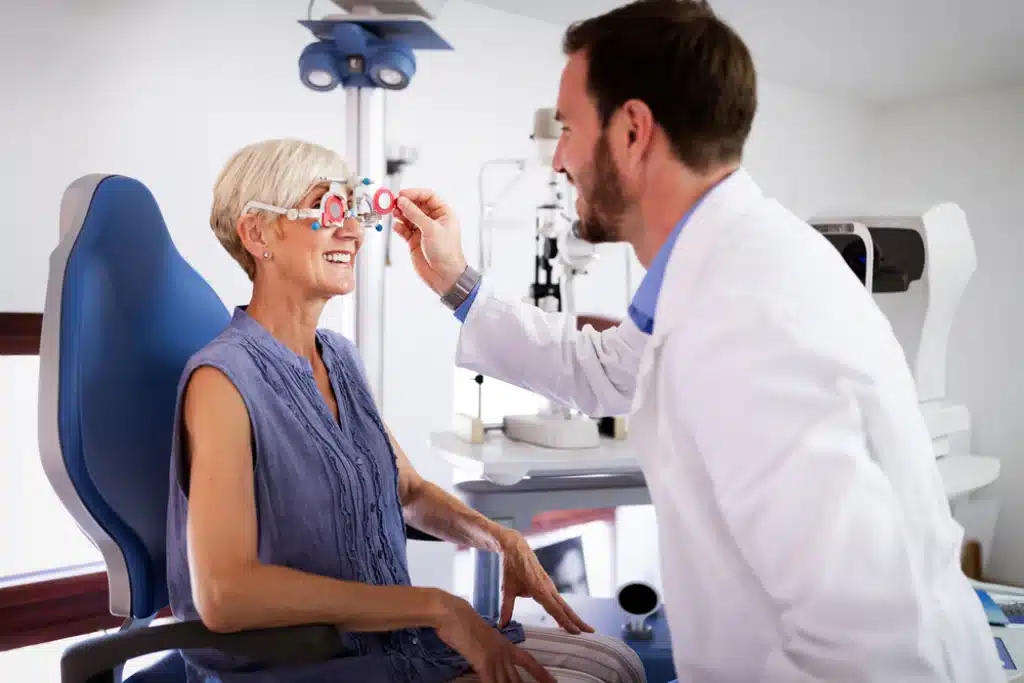Medically Reviewed by: Edward C. Wade, M.D., F.A.C.S.
Is My Vision Too Bad for LASIK?
Have you ever wondered, “Is my vision too bad for LASIK?” or “Can you get LASIK with really bad vision?” If so, Eye Center of Texas has some news that just might make your day. Technology has improved such that patients with severe vision impairments may be able to achieve improved vision with LASIK eye surgery.
Learn about the wide range of eye power levels compatible with LASIK and other requirements for LASIK eye surgery today.
Understanding refractive errors and diopters
There are a lot of misconceptions around who can and can’t have LASIK eye surgery, which is why we receive so many questions like “Is my vision too bad for LASIK eye surgery” or even, “Is my vision too good for LASIK?”
The confusion probably stems from a lack of understanding as to how we measure maximum and minimum prescription ranges for LASIK. These ranges are determined by the refractive errors specific to each patient’s eyes. Refractive errors — the light refraction errors created by a misshapen lens or cornea that cause common vision problems — are measured in diopters (D). Negative diopters indicate myopia (nearsightedness) and positive numbers indicate hyperopia (farsightedness).
What prescription is too high for LASIK?
When trying to find the answer to the question, “Is my vision too bad for LASIK?” patients often seek out specific diopter measurements standards. While some sites do provide these numbers, it’s extremely important to note that the range of diopters which LASIK can treat depends on the technology your surgeon uses. For that reason, we’ve given a more general overview of the appropriate prescription range for LASIK candidates.
- Myopia (Nearsightedness): Performing LASIK on eyes with myopia that is beyond a certain negative diopter measurement can cause nighttime vision problems and halos.
- Hyperopia (Farsightedness): Performing LASIK on eyes with hyperopia that is beyond a certain diopter measurement can cause nighttime vision problems and halos. The range of diopter measurements for farsightedness is smaller than that of myopia.
- Astigmatism (When both near and far objects are blurred): The astigmatism limits for LASIK are more variable. Each of the following has its own acceptable range, as is defined by your doctor.
- Astigmatism combined with myopia
- Astigmatism combined with hyperopia
- Mixed astigmatism patients
For those of you who are curious about LASIK for astigmatism, we recommend reading our article, Can LASIK correct astigmatism.
What are the requirements for LASIK eye surgery?
Can LASIK give you 20/20 vision? Yes, it can. However, you must also meet other requirements outside of prescription limits in order to be a good candidate for LASIK. These include:
- Having corneal tissue that’s thick enough — approximately 420 microns — for LASIK. Most healthy eyes have corneas that around 550 microns thick.
- Your eye health, in general, must be in good standing
- Your prescription must not change for 12 months
- You must not suffer from glaucoma, dry eyes, or cataracts
- You must have an average pupil size
- Women who are pregnant or nursing should wait to have LASIK.
If you meet all of these conditions, then you are likely an ideal candidate for LASIK eye surgery! However, even if you’re a perfect candidate for LASIK surgery, it’s important that you follow through with pre-LASIK preparation and choose a quality eye surgeon like those at Eye Center of Texas.
Do I have other laser eye surgery options for improved vision?
When your prescription or eye health disqualifies you from being a good LASIK candidate, it’s always worth speaking to your doctor about your other options.
For example, if you don’t qualify for LASIK, it’s possible that PRK eye surgery may be an option for you. PRK is LASIK’s predecessor and can have the same positive results as LASIK. It has different ranges of acceptable eye power and is available to some patients who do not meet all of the other requirements for LASIK eye surgery.
Occasionally, some patients even chose to have PRK LASIK enhancement after their original LASIK surgery.
20/20 vision (or better!) is possible with LASIK at Eye Center of Texas
The majority of patients who choose to have LASIK eye surgery report that their vision is now at 20/20 or better.
Don’t sit around wondering “Is my vision too bad for LASIK eye surgery?” and avoid taking action. You deserve clear vision. Eye Center of Texas, known for providing some of the best LASIK in Houston, is helping people restore their eyesight each and every day.
And remember: Even if your prescription doesn’t make you a candidate for LASIK now, that doesn’t mean LASIK will be unavailable to you for forever. Technology is always improving, and we encourage you to continue to check back.
To meet with our nationally recognized surgeons, call us at 713-395-1515 or contact us online to set up your consultation today.
Related Resources:
Financing Options Available
Apply today to find a financing option that meets your needs.
Our Locations
Houston/Bellaire
6565 W. Loop S., Suite 650Bellaire, TX 77401
Medical Office:
713-797-1010
Medical Fax:
713-357-7276
LASIK/Near Vision:
Office: 713-395-1515
Fax: 713-357-7278
Pasadena
4415 Crenshaw RoadPasadena, TX 77504
Medical Office:
281-977-8800
Medical Fax:
281-977-8877
Sugar Land
15200 S.W. Freeway, Suite 130Sugar Land, TX 77478
Medical Office:
281-277-1010
Medical Fax:
281-277-4504
Clear Lake
455 E. Medical Center Blvd., Suite 110Webster, TX 77598
Medical Office:
281-332-1397
Medical Fax:
281-282-9152
Katy
Greenhouse Medical Plaza2051 Greenhouse Road, Suite 110
Houston, TX 77084
Medical Office:
346-547-7070
Medical Fax:
281-214-2971
The Woodlands/Conroe
100 Medical Center Blvd., Suite 118Conroe, TX 77304
Medical Office:
936-647-1610
Medical Fax:
936-647-1620


